
Modern secular societies are bound not by gods, but by ideas such as property, justice, equality, and human rights. These are also beliefs, and thus myths, presented without a narrative scaffolding.
Credit: iStock Photo
In India, the phrase ‘itihasa-purana’ has been used for 2,500 years to refer to transmitted memories. Many assume that this is an ancient division between history and mythology. However, the split between history and mythology happened only in the 19th century with the use of the scientific method to unravel the past. For the Vedic people, the two words had very different meanings.
Itihasa deals with mortal characters and is narrated by storytellers who witness the events described. While Ramayana and Mahabharata are the primary itihasa, there are several dozen itihasas found in late Vedic texts such as Brahmanas and the Brihaddevata. Stories are located here within time. Characters are located within the four yugas that constitute the lifecycle of the world. Puranas deal with celestial beings, who live beyond the human realm. Characters here are located outside space and time.
For many, mythology is protohistory. Gods are just ancestors deified. For Christians, the Bible presents actual, not imaginary events. For Muslims, the Quran is a perfect transcription of a conversation with the divine, without any human intervention. Hindus get triggered when Christians and Muslims insist that Ramayana and Mahabharata are myths. But we need to ask ourselves if the following are facts or beliefs: Did God speak to a merchant in the desert through an angel? Was God’s son born to a virgin and did he resurrect after being killed? Did God walk on earth as a king, and then as a cowherd? Did the gods build the city of Troy and cause its downfall?
For historians, God or gods are not historical characters. These are at best metaphors, symbols, embodiments of beliefs, and vehicles of cultural truths, that glue communities together. History is the realm of humans.
Modern secular societies are bound not by gods, but by ideas such as property, justice, equality, and human rights. These are also beliefs, and thus myths, presented without a narrative scaffolding. In the 19th century, the word mythology was used only for polytheistic cultures. In the 20th century, the word mythology expanded to include monotheistic cultures too. All traditional knowledge was irrational and mythical. In the 21st century, the word mythology also includes atheistic cultures, for no culture is based on rationality. Humans need beliefs to grant their life meaning.
Many educated Hindus insist on viewing Ramayana and Mahabharata as history, and use celestial events like eclipses mentioned in the oldest manuscripts to date the events. As a result, Mahabharata has been dated to 3101 BCE. Ramayana is dated by different scholars to different dates: from 12209 BCE to 1920 BCE.
Historians believe that the epics, composed 2,000 years ago, reflect nostalgically on a period a thousand years earlier (1000 BCE), when Aryans had just moved into the Ganga-Yamuna doab. This is when, as per archaeologists, Painted Greyware (PGW) pottery has been found in the same region, indicating a shift from previous cultures. The manuscripts narrating the story are dated to 200 BCE to 200 CE, between the Mauryans who patronised Buddhists, and the Guptas who patronised Brahmins. It was a period of transition and turmoil when much of the North was controlled by nomads from Central Asia (Scythians, Parthians, and Kushans).
Ramayana and Mahabharata timelines are contested. So are their geographies. In today’s popular understanding, however, Ramayana stretches from the Ganga river basin through the Deccan plateau to the island of Sri Lanka in the Indian Ocean. However, this contradicts what the oldest manuscripts reveal. The geography of the epic does not go beyond the Vindhya mountains. The realm of the vanara (monkey people) and rakshasa (barbarians) is full of Sal trees, which are only found in the north, in the current-day states of Chhattisgarh, Jharkhand, and Odisha.
Mahabharata takes us northwards towards the Himalayas. The mountains are described as the realms of demons and gods. But today, caves in Maharashtra, built by Buddhists, are described by tourist guides as caves built by the Pandavas (Pandava-leni). Ashoka’s pillar was long considered the staff of Bhima (Bhim-ki-lathi). Bhimbhetka caves are said to be a spot visited (bhet) by Bhima.
The original itihasa world stretches from the Cedar forests of the north to the Sal forests of the south; nothing beyond the Vindhyas. But as Brahmins migrated southwards, as the concept of Aryavarta expanded to include other river valleys and even seacoasts, we find the epic worlds expand. During the time of the Chola in the 10th century, Sri Lanka was identified as the land of Ravana. During the time of the Vijayanagar Empire in the 15th century, Karnataka was identified with Kishkinda, land of the vanara. Konkan and Kerala coasts came to be identified with Parashuram. Southern mountains came to be called Daksina-Kailasa (Kailasa of the south). Southern rivers came to be called Daksina-Ganga (Ganga of the south). Southern cities came to be called Daksina-Kashi (Kashi of the south). Southern kings provided food for the war at Kurukshetra.
Mythology has worked well to unite India, far more than history ever could.
(Devdutt Pattanaik is the author of more than 50 books on mythology. X: @devduttmyth.)
Disclaimer: The views expressed above are the author's own. They do not necessarily reflect the views of DH.